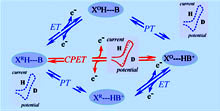Publication
710
Energy Environ. Sci., 5 (7), 7718-7731, 2012
DOI:10.1039/C2EE03241D
|
|
|
|
|
 |
Electrochemical approach to proton-coupled electron transfers: recent advances |
|
|
|
|
Jean-Michel Savéant
Université Paris Diderot, Sorbonne Paris Cité, Laboratoire d’Electrochimie Moléculaire, UMR 7591 CNRS, 15 rue Jean-Antoine de Baïf, F-75205 Paris Cedex 13, France
Association between proton and electron transfer is omnipresent in biological reactions (Photosystem II and a myriad of other systems) and in synthetic reactions (think of the huge number of available Pourbaix diagrams). The renewed interest for these proton-coupled electron transfers (PCET) is due to the possibility that proton (P) and electron (E) transfers be concerted (“CPET”), rather than stepwise, “EPT” or “PET”. The advantage of CPET pathways is that they skip the high energy intermediates involved in the stepwise pathways. Characterization of CPET pathways is therefore essential to the comprehension of a number of natural reactions. They are also likely to play a considerable role in the design of catalytic processes with the aim of tackling contemporary energy challenges. Electrochemistry, especially by means of non-destructive techniques like cyclic voltammetry, is an efficient means to address these problems. Modelisation of the CPET kinetics is based on a semi-classical treatment of heavy atoms (including the solvent) and a quantic treatment of protons and electrons. Driving force, solvent reorganization and proton tunneling are the main ingredients of the reaction kinetics. Application of the model is illustrated with the oxidation of an amino-phenol, mimicking the tyrosine–histidine couple in Photosystem II, as well as with an inorganic example involving the aquo–hydroxo–oxo sequence, MIIOH2, MIIIOH, MIVO, in transition metal complexes. The rate law and rate controlling factors are the same in the electrochemical and homogeneous versions of the model. Oxidation of simple phenol provides an illustration of the interest of combining electrochemical and photochemical approaches of the same reaction. It was also the occasion of a dive into the remarkable properties of water (in water) as proton carrier over large distances thanks to H-bond networks in concert with electron transfer. This Grotthuss-type CPET is compared to the behavior of a synthetic model molecule containing an H-bond relay between the proton donating and proton accepting groups, where the proton is transported by means of this H-bond train in concert with electron transfer. Finally it is shown that it is possible to break a bond between heavy atoms by means of proton and electron transfer, the three events being concerted, and consequently to obtain a substantial kinetic benefit. The attending theory is described and applied to the cleavage of an O–O bond. |

